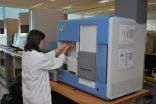(Press-News.org) Researchers of the University of Granada, in collaboration with the Centre for Sensory-Motor Interaction of the University of Aalborg, Denmark, and the University Rey Juan Carlos, Madrid, conducted a research on chronic impingement syndrome. The study revealed that excessive activation of specific neck and shoulder muscles during daily life or while playing sports –as swimming– is the cause of a high number of injury and shoulder
A Common Pain
The pattern of the pain originated in these muscles –sometimes in regions far from the shoulder– coincides with most of the symptoms suffered by patients attending health care centers for this type of problem. 25 out of 1,000 visits to the family doctor are related to shoulder pain, and the causes of this problem are several. The chronic impingement syndrome is considered the main cause for shoulder pain and disability.
The study conducted by Amparo Hidalgo-Lozano, Ph.D candidate of the department of Physiotherapy of the University of Granada, under the supervision of professor Manuel Arroyo Morales, opens the door to future tests to the efficacy of Physiotherapy as a non-invasive treatment for shoulder injury. Shoulder injury is the cause of 13% of sick leaves and implies a cost of 7 billion dollars in the USA.
This research was published in the last issue of the prestigious journal Experimental Brain Research.
INFORMATION:
Reference:
Hidalgo-Lozano A, Fernández-de-Las-Peñas C, Alonso-Blanco C, Ge HY, Arendt-Nielsen L, Arroyo-Morales M. Muscle trigger points and pressure pain hyperalgesia in the shoulder muscles in patients with unilateral shoulder impingement: a blinded, controlled study. Exp Brain Res. 2010 Feb 26.
Contact: Manuel Arroyo Morales. Departament of Physiotherapy of the University of Granada. Phone: +34 958 24 28 64. Mobile: +34 620 936138. E-mail: marroyo@ugr.es
Accessible on English version
Accesible en Versión española
Accessible sur le site Version française
Researchers at the University of Granada associate trigger points with shoulder injury
2010-10-01
ELSE PRESS RELEASES FROM THIS DATE:
Hydrogen fuel for thought
2010-10-01
New research by Rice University scientists suggests that a class of material known as metallacarborane could store hydrogen at or better than benchmarks set by the United States Department of Energy (DOE) Hydrogen Program for 2015.
The work could receive wide attention as hydrogen comes into play as a fuel of the future for cars, in fuel cells and by industry.
The new study by Rice theoretical physicist Boris Yakobson and his colleagues, which appears in the online Journal of the American Chemical Society, taps the power of transition metals scandium and titanium to ...
URI professor warns: TV viewing likely to make you fear sickness
2010-10-01
KINGSTON, R.I.-– September 30, 2010 –Watching television and its heavy dose of medical content in news and drama can lead to more concern about personal health and reduce a person's satisfaction with life according to a new study out of the University of Rhode Island.
The study, authored by Yinjiao Ye, assistant professor of communications studies found that TV viewing affects people's awareness of health-risks and whether they believe they can protect their own health. People develop these perceptions because TV viewing leads them to believe they have a greater likelihood ...
Tea leaves identified using neural networks
2010-10-01
A team of chemists from the University of Seville (US) has managed to distinguish between different kinds of tea leaves on the basis of their mineral content and by using artificial neural networks. This technique makes it possible to differentiate between the five main varieties of tea – white, green black, Oolong and red tea.
"This method makes it possible to clearly differentiate between the five types of tea – something that is often not easy to do by eye alone – by using analysis of the leaves' mineral content and then mathematically processing these data", José ...
Catalyst sandwich
2010-10-01
Northwestern University researchers have taken another step towards realizing a new class of polymerase chain reaction (PCR) enzyme mimics, opening the door for the development of highly sensitive chemical detection systems that go beyond nucleic acid targets.
The blueprint for building synthetic structures to detect and signal the presence of targets such as small molecule medical analytes (signalers of disease or bodily malfunction, such as neurotransmitters) and environmental hazards, such as TNT, to name just a few, is inspired by biology and its allosteric enzymes. ...
Testing African couples for HIV is cost-effective prevention strategy
2010-10-01
As researchers and policymakers work toward an effective HIV vaccine in a constrained global economy, cost-effective prevention strategies such as Couples Voluntary Counseling and Testing (CVCT) must take a larger role in efforts to decrease the rates of HIV/AIDS in Africa, says Emory University HIV/AIDS vaccine researcher Susan Allen, MD, MPH.
Allen, who has worked to combat the AIDS epidemic in Africa for more than 25 years, highlighted the value of CVCT and other cost-effective HIV prevention strategies today at the AIDS Vaccine 2010 Conference in Atlanta.
"The ...
Chromosomal break gives scientists a break in finding new puberty gene
2010-10-01
A break in the two chromosomes has given scientists a break in finding a new gene involved in puberty, Medical College of Georgia researchers report.
It's also helped clear up why some patients with delayed puberty have no sense of smell, said Dr. Lawrence C. Layman, chief of the MCG Section of Reproductive Endocrinology, Infertility and Genetics.
The WRD11 gene interacts with a transcription factor that appears to be involved in development of gonadotropin releasing hormones that enable sexual maturation as well as olfactory neurons in the brain, according to a study ...
Bedouin tribe reveals secrets to McGill's GA-JOE
2010-10-01
Van Den Ende-Gupta syndrome (VDEGS) is an extremely rare genetic disorder that is characterized by distinctive head and facial features, such as unusual eyelids, narrow and beaked noses, flat nasal bridges, jaw deformities, and a turned out lower lip. As part of McGill's "RaDiCAL" project (Rare Disease Consortium for Autosomal Loci), collaborators in Qatar conducted field research with three patients from biologically interrelated Bedouin families, and sent samples to Canada for analysis by GA JOE – a high-tech genome analyzing machine. The research effort was led by husband ...
Key leukemia defense mechanism discovered by VCU Massey Cancer Center
2010-10-01
Richmond, Va. (September 30, 2010) – Virginia Commonwealth University Massey Cancer Center researcher Steven Grant, M.D., and a team of VCU Massey researchers have uncovered the mechanism by which leukemia cells trigger a protective response when exposed to a class of cancer-killing agents known as histone deacetylase inhibitors (HDACIs). The findings, published in the Journal of Biological Chemistry, could lead to more effective treatments in patients with leukemia and other cancers of the blood.
"Our findings provide new insights into the ways such cancer cells develop ...
'Great strides' in treatment of stroke, headache, epilepsy
2010-10-01
MAYWOOD, Il. -- The latest advances in treating neurologic disorders such as stroke, headache, Parkinson's disease, epilepsy and sleep disorders are detailed in a special issue of the journal Neurologic Clinics.
Guest editor is Dr. Jose Biller, chairman of the Department of Neurology at Loyola University Chicago Stritch School of Medicine.
"Great therapeutic strides in the clinical neurosciences have been made in the past decades," Biller wrote in the preface to the November 2010 issue, now available online. "It is likely that subsequent decades will bring even greater ...
OHSU Toxicology Research Center issues public alert on popular hair salon treatment
2010-10-01
PORTLAND, Ore. — Oregon Health & Science University's Center for Research on Occupational and Environmental Toxicology (CROET) is responding to concerns raised by Portland-area hair salons about a product used for hair straightening. CROET has issued two public alerts describing its findings on the possible negative health impacts of this product.
The product being tested is called Brazilian Blowout. After receiving two samples from Portland-area salons, CROET asked the Department of Consumer and Business Services' Oregon Occupational Safety & Health Division to chemically ...



